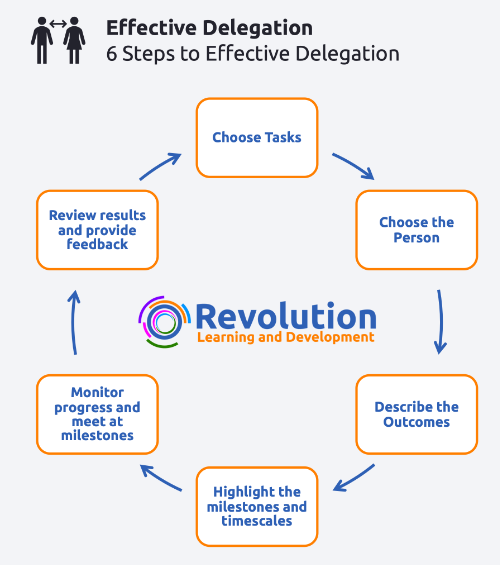Why Should You Delegate?
Knowing how to delegate tasks to your team is essential when it comes to leading and managing people or managing your own time. No leader or manager can get everything done on their own and, delegation is also a highly effective development method to provide team members with new skills.
To read more about why you should delegate and some of the reasons why you might not, see our post titled Why Leaders Need To Delegate and Why They Don’t.
There are many benefits of delegation, chief among them being it saves you time, you get more things done and it helps to develop the skills of the people you delegate to.
What is Delegation?
Delegation describes the process of one person passing the responsibility and ownership of a task or series of tasks to someone else. A task can be delegated in its entirety or it could be a small proportion of a larger task.
It’s an important part of effective time management, general leadership and management and project management.
How to Delegate Tasks in 6 Steps
A common question we get asked, for example in our time management training course is how do you delegate tasks effectively? When asked this question we demonstrate a 6 step process.
So, what are the 6 steps to delegation? Here is how to delegate tasks to your team members or to other people in 6 simple steps. You can use the links below to jump to each step:
- Choose which tasks to delegate
- Choose the right person
- Describe the outcomes you want
- Highlight milestones and timescales
- Monitor progress and meet at milestones
- Review results and provide feedback
You can think of the above as a cycle or a delegation process as shown in the image below.

Choose Which Tasks to Delegate
A common mistake that many people make when deleting is that they delegate the wrong tasks. You can’t delegate everything. Being careful about the types of tasks you delegate will ensure better success when delegating.
Delegating one-off tasks isn’t going to give you any benefit. Instead, delegate repeatable tasks. Delegate it once and the person who now has responsibility for the task can do it over and over again. This way you get a long term return on the time that you spend delegating.
If you delegate one-off tasks, you are not going to see the return described above.
Choose the Right Person to Delegate to
In the same way that you shouldn’t delegate just any task, we also shouldn’t delegate to just anyone. Picking the right person to complete your task is essential to delegation success and how to delegate tasks effectively.
When it comes to picking the right person for our tasks, we should look at 2 things:
- Level of skill – can they already do the task or have the skills to do the tasks we are delegating?
- Level of willingness for new tasks – does the person show an eagerness to want to learn new things?
In an ideal scenario, we want a person who is high in both of the above. If that person isn’t available, then you should consider which way to go next. Do you have the person with the right skills and you believe that you can influence their willingness. Or, do you have a person that is eager to learn and can pick up the skills quickly?
You also probably want to consider if the person will enjoy doing the task. If they do, you will find it easier to delegate the task to them. This is how to delegate tasks and generate buy-in and ownership from the person you are delegating to.
Describe the Outcomes
Think clearly about what you want as your final outcome. You need to be able to communicate this clearly to the person you are delegating to. Remember, you will only get what you ask for. If your description is not clear, you won’t get what you want.
If it’s a large task, consider breaking it down into smaller tasks and delegate one task at a time. This way you can be clear about each stage and not overwhelm the person you are delegating to with a task that is too big or too complex.
Only describe what you want, not how to do it. Leave that up to the person you are delegating to. This way you can pass the ownership over and make them feel a part of the process.
Explain the why > ask for the how > agree on the what (actions). This is how to delegate tasks and get the right outcome that you need.
Highlight the Milestones and Timescales
If you are delegating a large task and can’t break it up as described in the previous section, you should agree on some milestones. These are way-points or times during the process of the task where you meet to discuss progress.
This is because it is easier to carry out a course redirection at a milestone than it would be at the end of the task. Communicate when the overall task should be completed by, then agree on some milestones where you will meet to agree on progress.
Don’t interfere before then. Meet only at the milestones as getting involved in-between could be seen as micromanaging and may have a detrimental impact on the overall success of your delegated task.
One of the questions that we get asked about delegation is how to monitor delegated tasks? You could agree with the person who you have delegated to how they will report progress, for example, a weekly report. This should not influence you to jump in and change anything until the next milestone.
Monitor Progress and Meet at Milestones
Once your task milestones are agreed and the task is underway, meet at the agreed milestones. The outcome of each of these meetings should result in 1 of 3 decisions:
- to continue to the next stage (keep going)
- Keep going with some changes to the next stage of the plan
- Stop the task completely
Your decision should be based on the progress of the delegated task and how likely it is to deliver the original result you wanted.
Review Results and Provide Feedback
Once all parts of your task are completed, now comes the review of how successful the task was and to provide some overall feedback to the person who carried out the task for you. Use a mix of positive and developmental feedback and make sure this feedback is constructive. See this article on constructive feedback for more details. This is how to delegate tasks and see the person motivated so you can delegate to them again in future.
Delegation Skills Training Course
Want more tips on how to delegate tasks effectively? We cover the 6 steps to effective delegation above in much more depth in our Delegation Skills Training Course. We deliver our delegation skills training course as an online training course and an in-person training course.












